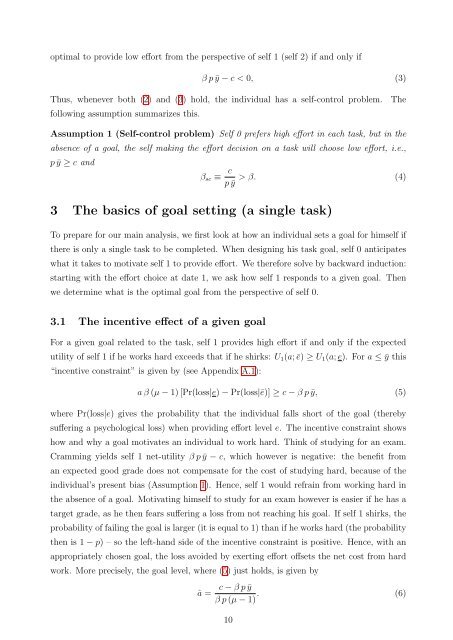Motivational Goal Bracketing - School of Economics and ...
Motivational Goal Bracketing - School of Economics and ...
Motivational Goal Bracketing - School of Economics and ...
You also want an ePaper? Increase the reach of your titles
YUMPU automatically turns print PDFs into web optimized ePapers that Google loves.
optimal to provide low effort from the perspective <strong>of</strong> self 1 (self 2) if <strong>and</strong> only if<br />
β p ¯y − c < 0, (3)<br />
Thus, whenever both (2) <strong>and</strong> (3) hold, the individual has a self-control problem. The<br />
following assumption summarizes this.<br />
Assumption 1 (Self-control problem) Self 0 prefers high effort in each task, but in the<br />
absence <strong>of</strong> a goal, the self making the effort decision on a task will choose low effort, i.e.,<br />
p ¯y ≥ c <strong>and</strong><br />
βsc ≡ c<br />
p ¯y<br />
> β. (4)<br />
3 The basics <strong>of</strong> goal setting (a single task)<br />
To prepare for our main analysis, we first look at how an individual sets a goal for himself if<br />
there is only a single task to be completed. When designing his task goal, self 0 anticipates<br />
what it takes to motivate self 1 to provide effort. We therefore solve by backward induction:<br />
starting with the effort choice at date 1, we ask how self 1 responds to a given goal. Then<br />
we determine what is the optimal goal from the perspective <strong>of</strong> self 0.<br />
3.1 The incentive effect <strong>of</strong> a given goal<br />
For a given goal related to the task, self 1 provides high effort if <strong>and</strong> only if the expected<br />
utility <strong>of</strong> self 1 if he works hard exceeds that if he shirks: U1(a; ē) ≥ U1(a; e). For a ≤ ¯y this<br />
“incentive constraint” is given by (see Appendix A.1):<br />
a β (µ − 1) [Pr(loss|e) − Pr(loss|ē)] ≥ c − β p ¯y, (5)<br />
where Pr(loss|e) gives the probability that the individual falls short <strong>of</strong> the goal (thereby<br />
suffering a psychological loss) when providing effort level e. The incentive constraint shows<br />
how <strong>and</strong> why a goal motivates an individual to work hard. Think <strong>of</strong> studying for an exam.<br />
Cramming yields self 1 net-utility β p ¯y − c, which however is negative: the benefit from<br />
an expected good grade does not compensate for the cost <strong>of</strong> studying hard, because <strong>of</strong> the<br />
individual’s present bias (Assumption 1). Hence, self 1 would refrain from working hard in<br />
the absence <strong>of</strong> a goal. Motivating himself to study for an exam however is easier if he has a<br />
target grade, as he then fears suffering a loss from not reaching his goal. If self 1 shirks, the<br />
probability <strong>of</strong> failing the goal is larger (it is equal to 1) than if he works hard (the probability<br />
then is 1 − p) – so the left-h<strong>and</strong> side <strong>of</strong> the incentive constraint is positive. Hence, with an<br />
appropriately chosen goal, the loss avoided by exerting effort <strong>of</strong>fsets the net cost from hard<br />
work. More precisely, the goal level, where (5) just holds, is given by<br />
â =<br />
c − β p ¯y<br />
. (6)<br />
β p (µ − 1)<br />
10
















